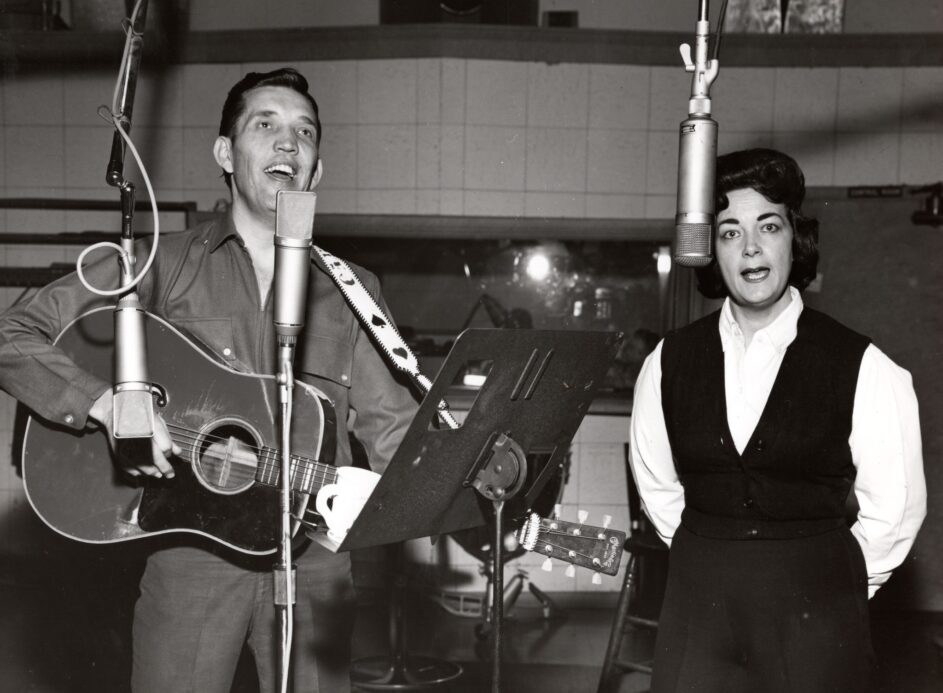Carl Robert Butler (1924-1992) and Pearl Dee Jones Butler (1927-1988) emerged from the vibrant tapestry of local country music to become one of the nation’s most beloved and enduring country music couples during the 1960s and 1970s. Hailing from working class neighborhoods in North Knoxville, their journey was not only one of musical trials and triumphs but also a testament to the strength of their personal and professional partnership.
Carl’s early exposure to country music icons Jimmie Rodgers and Roy Acuff and local legends, such as Willie G. Brewster, “Pudgy” Douglas, “Bliss” Gibson, and “Shorty” Sams, laid the foundation for his future in country music. Carl’s proficiency with the guitar and his distinctive, open-throated vocal stylings earned him a spot on local radio, beginning with the Rocky Mountain Boys on WROL-Radio.
Pearl brought her own unique set of talents to the duo. Raised in a musical family, Pearl developed a passion for singing from a young age. Her harmonious voice and ability to connect emotionally with audiences complemented Carl’s style, creating a synergy that eventually defined their musical legacy.
The couple, who likely first met at Stair Technical High School in Knoxville, married in 1947, and they embarked on their musical journey in the post-World War II era, navigating the evolving landscape of local radio and country music, Carl signing in various groups, Pearl working at one of Cas Walkers’ grocery stores to make ends meet.
Two years after recovering from a near-death car wreck, Carl signed his first record label, cutting sides for Columbia on November 1, 1950, at WROL’s studio in the Hamilton National Bank Building (present Holston Building). With Carl’s fame on the rise, he kept a hectic tour schedule, traveling more than 100,000 miles per year with an ever-rotating crew of band members. At times, Pearl accompanied Carl, but most often, she was at home in Knoxville.
In 1957, the Butlers moved to Nashville in search of a fresh start and new opportunities. “The good lookin’ boy from over East Tennessee way” quickly found a spot on the Grand Ole Opry, but it would not be until February 1962, when Carl and Pearl, the duo, was formed. On the eve of their wedding anniversary, they recorded “Don’t Let Me Cross Over.”
Pearl thought it was a demo; Carl knew it was a hit. The song went to No. 1 in just four weeks, where it remained for 11 non-consecutive weeks, not only showcasing their musical prowess but also laying the foundation for a string of successful singles and albums that solidified their place in country music history.
The Butlers’ instant fame fueled an endless succession of live performances – every barn dance, grocery store opening, park dedication, church social, you name it. For the right price, Carl and Pearl would come play in your town – together. In fact, The Butlers became ambassadors for enduring love in the public eye.
Their commitment to each other through the highs and lows of life – and especially in an industry known for its challenges ¬– served as an inspiration to fans and fellow musicians alike.
By the 1980s, country music had become “country pop,” a trend that the Butlers did not embrace, choosing to remain true to that early, open-throated “Knoxville sound.” The Butlers slowly slipped out of fashion, but their influence extended beyond their own fame.
The Butlers were known for their generosity and support of emerging artists, such as Dolly Parton, June Webb and Margie Bowes. The Butlers were also known for their storytelling which inspired subsequent generations of musicians who, at times, covered their hits; Ricky Skaggs, as an example, revived Carl’s 1960 tune “Crying My Heart Out Over You,” taking it to No. 1 on the country music charts in 1981.
And, perhaps most endearingly, the Butlers were known for their hospitality, especially at their estate, Crossover Acres, in Franklin, Tennessee, which helped foster a sense of community among fellow performers and fans, leaving a legacy that reached far beyond their own discography.
Pearl passed away first; Carl followed four short years later. Allen “Junior” Butler, Carl’s younger brother, instinctively preserved as much as he could from Carl and Pearl’s storied career– newspaper clippings, photographs, home movies, recordings and keepsakes, much of which had been left behind, stuffed into large trunks.
Thanks to the generosity of the Junior Butler Family and the efforts of media archivist Bradley Reeves, these materials are presented for public view for the first time in the Museum of East Tennessee History’s feature exhibition, They Sang What They Lived: The Story of Carl and Pearl Butler. You are invited to come experience a story which reminds us that in the heart of a song, the essence of a partnership, and the spirit of a country music, the Butlers left a legacy that continues to resonate with audiences today.
They Sang What They Lived is open through August 18, 2024, at 601 S. Gay Street in downtown Knoxville.
Adam H. Alfrey is assistant director for historical services, Knox County Public Library

